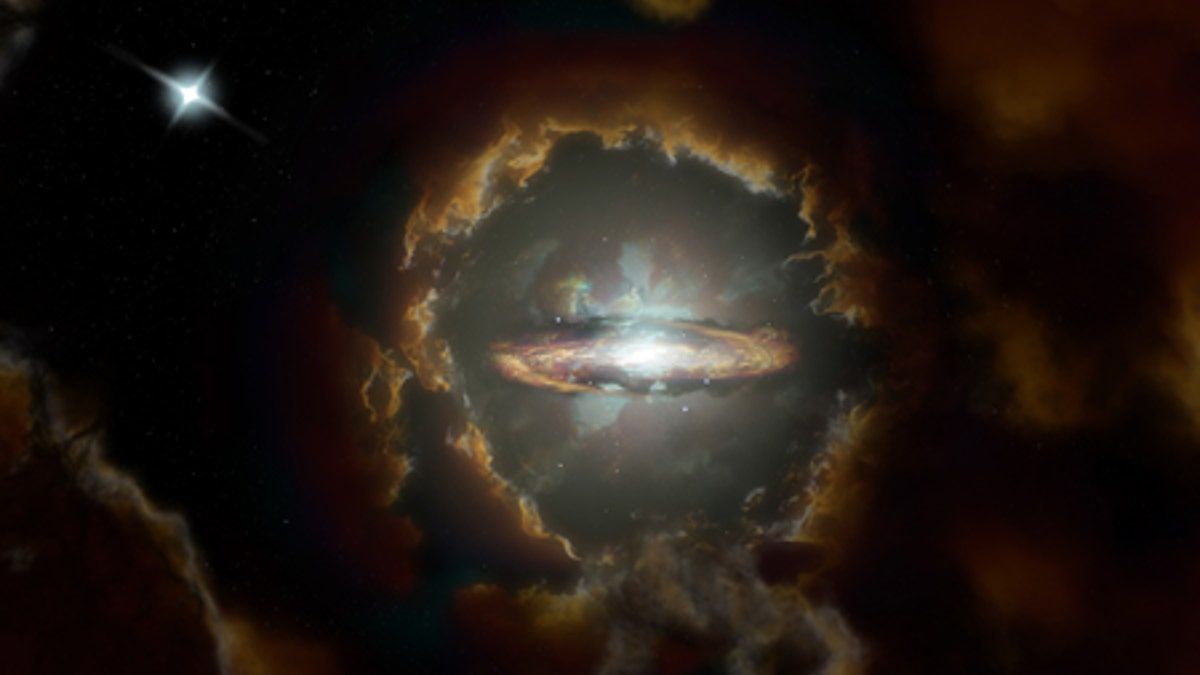Fox News Flash top headlines for May 21
Fox News Flash top headlines are here. Check out what's clicking on Foxnews.com.
A massive, rotating disk galaxy from the early universe has been discovered by an international team of astronomers.
Galaxy DLA0817g, dubbed the "Wolfe Disk" after the late astronomer Arthur M. Wolfe, was discovered using the Atacama Large Millimeter/submillimeter Array (ALMA) in Chile. The Wolfe Disk is the most distant rotating disk galaxy ever observed, according to UC Santa Cruz, which participated in the research.
The research has been published in the journal Nature.
BRIGHTEST EVER SUPERNOVA DISCOVERED, STUNNING SCIENTISTS
Similar to our Milky Way, the galaxy spins at 170 miles per second, the researchers explained in a statement.

An artist’s impression of the Wolfe Disk. The galaxy was first discovered when the Atacama Large Millimeter/submillimeter Array (ALMA) examined the light from a more distant quasar (top left). (Credit: NRAO/AUI/NSF, S. Dagnello)
“Its properties are astonishingly similar to our own galaxy, despite being only 1.5 billion years old,” said the paper’s co-author J. Xavier Prochaska, professor of astronomy and astrophysics at UC Santa Cruz, in the statement.
The researchers note that most huge disk galaxies, like our own Milky Way, reach their large mass relatively late in the 13.8-billion-year history of the universe.
BLACK HOLE, 1,000 LIGHT-YEARS FROM EARTH, DISCOVERED
“While previous studies hinted at the existence of these early rotating gas-rich disk galaxies, thanks to ALMA we now have unambiguous evidence that they occur as early as 1.5 billion years after the Big Bang,” said lead author Marcel Neeleman of the Max Planck Institute for Astronomy in Germany.
![ALMA radio image of the Wolfe Disk, seen when the universe was only ten percent of its current age. (Credit: ALMA [ESO/NAOJ/NRAO], M. Neeleman; NRAO/AUI/NSF, S. Dagnello)](https://a57.foxnews.com/static.foxnews.com/foxnews.com/content/uploads/2020/05/1200/675/WolfeDisk2.jpg?ve=1&tl=1)
ALMA radio image of the Wolfe Disk, seen when the universe was only ten percent of its current age. (Credit: ALMA [ESO/NAOJ/NRAO], M. Neeleman; NRAO/AUI/NSF, S. Dagnello)
NASA’s Hubble Space Telescope and the National Science Foundation’s Karl G. Jansky Very Large Array (VLA) were also used to study the Wolfe Disk.
The galaxy was first discovered in 2017 by ALMA when it examined the light from a more distant quasar, or highly active supermassive black hole. "The light from the quasar was absorbed as it passed through a massive reservoir of hydrogen gas surrounding the galaxy, which is how it revealed itself," the researchers explained, in the statement. The latest observations revealed the Wolfe Disk’s rotation.
77-YEAR-OLD AMATEUR ASTRONOMER HELPS MAKE STUNNING DISCOVERY
In a separate project, scientists recently discovered the brightest ever supernova.
CLICK HERE TO GET THE FOX NEWS APP
The supernova, dubbed SN2016aps, is the brightest, most energetic and likely the most massive supernova that has ever taken place, according to the Harvard and Smithsonian Center for Astrophysics in Cambridge, Mass.
Follow James Rogers on Twitter @jamesjrogers





















